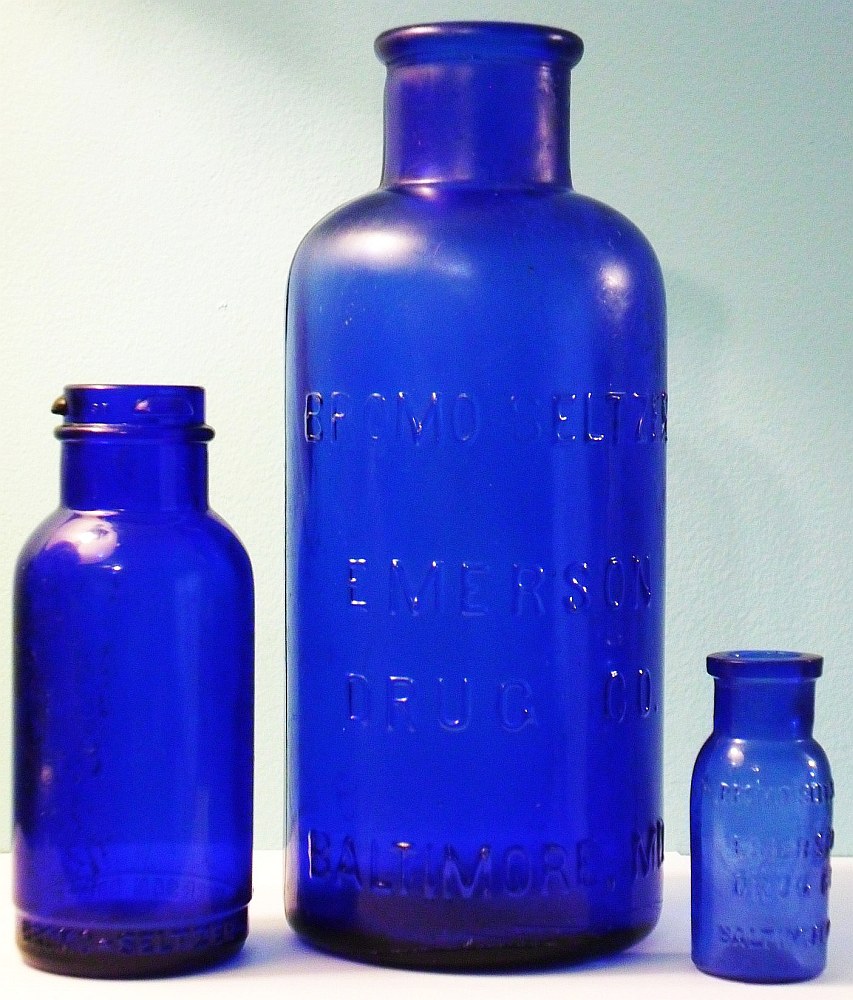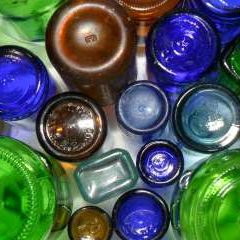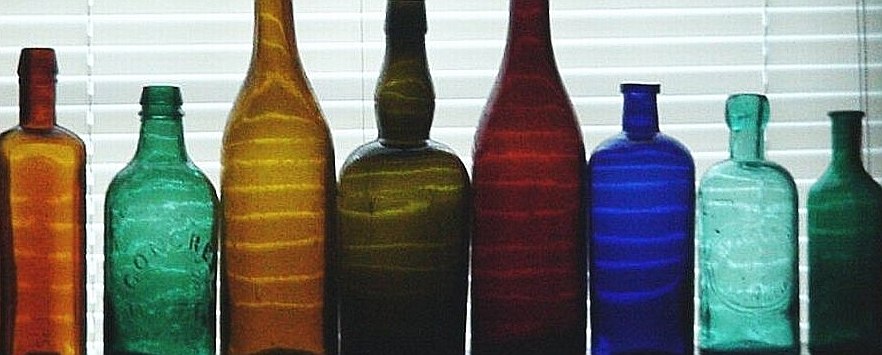Bromo-Seltzer Emerson Drug Co. Baltimore, MD.
Bromo-Seltzer was an extremely popular drug, in the form of a powder, introduced in about 1888 by Isaac Emerson, in Baltimore. This concoction was heavily promoted as a remedy for “sick headache”, upset stomach, headache, hangover, and other maladies. The exact formula varied somewhat in the earlier years, with the main active ingredient (originally) being sodium bromide. The recipe was eventually changed about 1975, with the sodium bromide being removed entirely. (The last time Bromo-Seltzer was available for retail sale seems to have been about 2011. See my notes near the bottom of this article).
The bottles are usually found in cobalt blue glass (they are also rarely seen in aqua and clear glass), in a variety of sizes and minor embossing variants. The earlier bottles are hand-blown with a tooled lip, and the later examples are machine-made. The last machine-made types have a screw-threaded lip.
WARNING: (this paragraph first posted February 23, 2014, updated July 19, 2015). It has come to my attention that unscrupulous ebay auction sellers have recently listed old Bromo-Seltzer bottles in a peculiar dull greenish color…… I would give the color a term such as swampy moss green, olive green amber, burnt olive green or dirty mustard green!
Some bottles are also showing up in peculiar shades of dark teal blue, “midnight blue”, “dark ink blue”, very dark teal green or “Prussian Green”. (Some of these colors may or may not be “nuked”. Please see my note below about the teal green color).
ADVERTISEMENT
Although these bottles could theoretically show up virtually anywhere, some of them appear to be originating from sources in Florida. MOST OF THESE BOTTLES WERE EVIDENTLY ORDINARY COBALT BLUE BOTTLES WHICH HAVE UNDERGONE “NUKING” (irradiation) to change their color to a “rare” color shade, increasing the “perceived” value to bottle collectors. Be aware that the color is not believed to be “original” or “authentic”. Also, please see my webpage on this site about Artificially purpled bottles. Artificial irradiation can change glass from an original aqua or blue color to other shades including purple, depending on the exact content of the glass batch “recipe”.
(Note: Someone has written to me recently [3/2016] who stated he has personally dug a few Bromo-Seltzer bottles in a dark teal green from an old dumpsite and they are definitely authentic, not nuked, so I am adding this paragraph 4/12/2016.) I will reserve judgment on these color variants to others…………… diggers/collectors who are more knowledgeable on dug Bromo-Seltzer bottles and the range of colors that have been found. I also invite anyone to write to me directly (my email address is listed in the “CONTACT NOTES” paragraph near the bottom of any page on this site) if they know of teal green or any other colors of these bottles (any colors other than cobalt blue) that they have personally dug, and are absolutely sure they are “as originally found”. THANK YOU!
(Note: Hand-blown (mouthblown) bottles will have two vertical mold seams along the sides of the bottle that gradually “fade out” or appear to be “erased” as the seam reaches closer to the top rim. In contrast, machine-made bottles have mold seams that are usually visible clear up to the top of the bottle, often extending up onto the very top rim).
The largest size bottles are somewhat scarcer, and harder to find than the typical small size (most common) which measures, in general, about 2 and 5/8″ in height.

Many, many millions of these glass bottles were made, and the embossed lettering varies somewhat with slight variations in the exact placement, size and shape of the letters. Some bottles exhibit the results of mold-cutting errors, for instance sometimes the “Z” in “Seltzer” is embossed backwards (as in the case of the small bottle on the right in the accompanying photo). Incidentally, that particular bottle is an older version, with a “squared band” lip, believed to date from the early years of Bromo production, circa early 1890s. In contrast, the great majority of the smaller Bromo bottles have a “rounded band” lip.
Hundreds of different molds were utilized in the long stretch of time that these bottles were made. An examination of bottles shows many that carry only mold numbers on the base. These mold numbers (one or two-digit numbers) do not convey any precise information as to when the bottle was made. However, because of the high quantities of machine-made Bromo-Seltzer bottles seen with these mold numbers, it is very likely that they are products of Maryland Glass Corporation.
ADVERTISEMENT
The very first Bromo-Seltzer bottles were believed to have been produced by Cumberland Glass Manufacturing Company, Bridgeton, New Jersey in the very late 1880s or early 1890s. No doubt other unidentified glassmakers also produced them. The earliest bottles blown for Bromo-Seltzer may have been unembossed, leaving their identification tenuous at best.
Maryland Glass Corporation, starting production in 1907, was a glass manufacturer owned by Emerson Drug Company and was built specifically to be operated as a vehicle for producing the vast quantities of Bromo-Seltzer bottles necessary. Philip I. Heuisler, a close business partner with Isaac Emerson, served as it’s president.
As time went on, Maryland concentrated most heavily on the manufacture of many types of cobalt blue bottles and jars and other blue glassware. Maryland Glass, no doubt, produced more of the B-S bottles than any other manufacturer. The most common mark used by Maryland Glass Corporation is their “M inside a circle” . See more info on Maryland Glass Corporation and their marks here in this article: “Maryland Glass Corporation / M in a circle trademark”
All of the earliest Bromo-Seltzer bottles were handmade, presumably including most if not all of the Cumberland Glass production, as well as the first few years of Maryland Glass production.
From in-depth research by collector, researcher and Bromo Seltzer museum curator Ernie Dimler, it is now believed that Maryland Glass Co. Bromo-Seltzer bottles were made by hand from 1907 to the 1910-1911 period. By 1911, production was switched over to machine, and in about 1914 Owens automatic bottle-making machines was put into use at the plant.
Most, if not all, of the CORK-top Bromo-Seltzer bottles made by Maryland date between 1907 and circa 1921. Around 1921, the cork-top style was phased out and the “lug-style finish” was phased in. The lug type bottles have 3 lugs (small protrusions or tabs) spaced equally around the top of the bottle. The lug finish is believed to have been phased out around 1952 and the “continuous thread” finish (the “normal” threaded top) was began in about that same year.
The “M in a circle” trademark used by Maryland Glass was introduced in about 1921, around the same time the lug finish was being phased in.
Although I have previously posted here that I believed Illinois Glass Company made some of the early Bromo-Seltzer bottles, marking the bottom with a diamond with a dot inside, I now doubt that this is correct. There are a number of bottles found with geometric shapes on the base (along with an arrangement of dots) and these were most likely made by Maryland Glass Corporation in the early years of their handmade operation.
Some Bromo Seltzer bottles were also believed to have been produced by Hazel Atlas Glass Company (or it’s predecessor, Hazel Glass Company). However, that information is now in doubt as well, as discussed on Bill Lockhart’s exhaustive webpage on Bromo-Seltzer bottles here.
Another confirmed maker of Bromo-Seltzer bottles would be George Jonas Glass Company, Minotola, New Jersey (1896-1908), as this is specifically mentioned on page 271, The Glass Gaffers of New Jersey, by Adeline Pepper (1971).
Bromo-Seltzer bottles are so plentiful that they do not have a high intrinsic value, but because of their highly attractive cobalt blue color, they are very popular with glass and bottle collectors and non-collectors alike, and can even add color and interest to interior room design. Many of them are sold on internet auction sites such as ebay, and other antique and collectible sites.
The switch from glass to plastic Bromo Seltzer bottles – circa 1983?
[This paragraph edited July 13, 2022] : Exactly when the last glass Bromo-Seltzer bottles were made is currently uncertain, but possibly in about 1983. I have previously written on this site that BS glass bottles were probably phased out sometime in the 1950s or early 1960s. That is absolutely incorrect. (Bill Lockhart, in his articles for Sha.org, estimates the last glass bottles were made in the early 1970s, perhaps 1971).
Please see a message sent to me by Ron (June 24, 2013) posted in the Comments section farther down on this page. He stated that the glass bottles might have been discontinued not long after 1956 (within a year or two). However, I later received a message from Mike Johnson (posted 9-24-2015) and he is fairly certain that cobalt blue glass bottles were made for Bromo-Seltzer until about 1981 (see his post in the “Comments” section of this page also). Recently (7-2022) I received a note from another reader (Richard Kriley) and he sent me photos of a glass bottle, still labeled, bearing what appears to be a 1985 expiration date stamped on the side. After more internet searching, I found photos of other bottles (made of cobalt glass, labeled, and with metal lids) with expiration dates including October of 1985, November of 1985, and April of 1986. Exactly how long a period of time is typical between the sell date and the expiration date on these bottles is unclear. (Do you know? Please contact me!). But my guess would be that the bottles were sold around 2 to 3 years before the expiration date came around. So I am currently, until further notice, placing the date of the most recent Bromo-Seltzer glass bottles at about 1983. I invite further discussion on the subject, and if anyone has concrete documentation on when the very last glass bottles (not plastic) manufactured for Bromo-Seltzer (for normal retail sale) were made, please write!
The Emerson Drug Company (and it’s subsidiary Maryland Glass) was sold to the Warner-Lambert Pharmaceutical Company in 1956. In 1968, the Dorsey Corporation of Chattanooga, TN acquired the glass plant from Warner-Lambert, although it continued to operate under the “Maryland Glass Corporation” name.
In 1978 the Maryland glass plant was sold by Chattanooga Glass Company to Steve Kelly, who soon ran into financial problems with the property and filed for bankruptcy in 1979. By late 1980 the workers were being laid off, and the glass plant was closed down completely by February of 1981.
The product Bromo-Seltzer was continued to be sold after 1975, which was evidently the year when the formulation was changed and sodium bromide was removed from the “recipe” for the medicine. Eventually production of Bromo-Seltzer was moved entirely to Canada. (Any glass bottles that contained Bromo-Seltzer that were made after about 1981 would have been made by another glass company besides Maryland Glass Corporation).
There is confusion on when the Bromo-Seltzer product itself was completely taken off the market. Some sources have given 2008 as the year when the company stopped producing the product and went out of business. During the last years of the product (and those exact years are unclear to me at the present time), it was packaged in plastic bottles, and (later) in plastic, foil or paper packets.
From this webpage on Amazon (from reading product reviews from purchasers), the last year that Bromo-Seltzer seems to have been available for sale (online only) was approximately 2011. [Edited 4/16/2024 – that page is no longer active and was deleted].
NOTE: For a very informative, detailed treatise on BROMO-SELTZER bottles, please check out this article (this is a .PDF file) written by Bill Lockhart from his research along with info submitted by several other glass researchers. Bill discusses the many different Bromo bottle variants made over the years, with an estimated timeline: https://sha.org/bottle/pdffiles/Bromo-Seltzer.pdf
Bill also goes into more detail on Maryland Glass Corporation in this article:
https://sha.org/bottle/pdffiles/MarylandGlass.pdf
For more information on the Bromo Seltzer Art Tower in downtown Baltimore, see this article:
https://www.bromoseltzertower.com/visitor-info/museum
For a little more background information on Bromo-Seltzer, check https://en.wikipedia.org/wiki/Bromo-Seltzer .
For an extensive list of glass manufacturers’ marks on bottles, fruit jars, electrical insulators, tableware and other glassware, please click here to go to Page One of the “Bottle Marks Pages“.
Click here to go to my site Home Page.
ADVERTISEMENT


